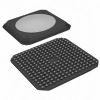Features: · Four Independently Configurable Wideband Down-Converter or Up-Converter Channels
− Four Channel Down Convert Mode
− Four Channel Up Convert Mode
− Two Channels Down and Two Channels Up Mode
· Down-Conversion Channel Mode
− Input Rates to 160-MSPS for Four Channels, 320-MSPS for Two Channels in Double Rate Mode
− Four Wideband Down-Conversion Channels Support UMTS Standards
− 115-dB SFDR
− FIR Filter Block Consists of 16 Cells Providing Up to 256 Taps Per Channel
− 64 Parallel Input Bits and 64 Parallel Output Bits Provide Flexible I/O Options
− Many Multiplex Output Options
· Up-Conversion Channel Mode
− Output Rates to 160-MSPS for Four Channels, 320-MSPS for Two Channels
− Four Up-Conversion Channels Support UMTS Standards
− FIR Filter Block Consists of 16 Cells Providing up to 256 Taps Per Channel
− 64 Parallel Input Bits and 64 Parallel Output Bits Provide Flexible I/O Options
− Multiple Real and Complex Outputs
− Two Channel Double Rate Real Output Mode With Rates to 320 MSPS
− Outputs Can Be Independent, Summed Into Two or One Output(s), and Optionally Merged With Multiple GC5016 Chips
· JTAG Boundary Scan
· 3.3-V I/O, 1.8-V Core
· Power Dissipation: <1 W for Four Channels
· Package: 252-Ball, 17-mm PBGA, 1-mm Pitch APPLICATIONS
· Cellular Base Transceiver Station Transmit and Receive Channels
− WCDMA
− CDMA2000
· Radar
· General Filtering
· Test and MeasurementSpecifications
| |
GC5016 |
| Pad ring supply voltage, VPAD |
−0.3 V to 4 V |
| Core supply voltage, VCORE |
−0.3 V to 2.3 V |
| Input voltage (undershoot and overshoot), VIN |
−0.5 V to VPAD+0.5 V |
| Storage temperature, Tstg |
−65°C to 150°C |
| Junction temperature, TJ |
105°C |
| Lead soldering temperature (10 seconds) |
300°C |
| ESD classification |
Human body model |
2 kV |
| Machine body model |
200 V |
| Charged device model |
500 V |
| Moisture sensitivity |
Level 3 |
DescriptionThe GC5016 is a flexible wideband 4-channel digital up-converter and down-converter. The GC5016 is designed forhigh-speed, high bandwidth digital signal processing applications like 3G cellular base transceiver station transmitand receive channels. The GC5016 is also applicable for general-purpose digital filtering applications. The four dentical processing channels can be independently configured for up-conversion, down-conversion, or a combination of two up-conversion and two down-conversion channels.
In up-conversion mode, the channel accepts real or complex signals, interpolates them by programmable amountsranging from 1 to 4096, and modulates them up to selected center frequencies. The 4 digital up-converter signals can be output individually, summed together on one or two outputs on a single GC5016, or optionally summed between multiple GC5016s. Channels can be used in pairs to increase the output sample rate, to increase filtering capacity, to increase the input bandwidth, or any combination. Each channel contains a user programmable input filter (PFIR), which can be used to shape the transmitted signal's spectrum or as a Nyquist transmit filter for haping digital data such as QPSK, GMSK, or QAM symbols.
In down-conversion mode of GC5016, the channel accepts real or complex signals, demodulates them from selected carrierfrequencies, decimates them by programmable amounts ranging from 1 to 4096, applies a gain from a user defined automatic gain control, and produces 20-bit outputs. The frequencies and phase offsets of the four sine/cosine sequence generators can be independently specified, as can the decimation and filtering of each circuit. Channels can be synchronized to support beam forming or frequency hopped systems. The output of GC5016 from the down-conversion channel is formatted and output in up to four output ports as either real or complex data.

 GC5016 Data Sheet
GC5016 Data Sheet







